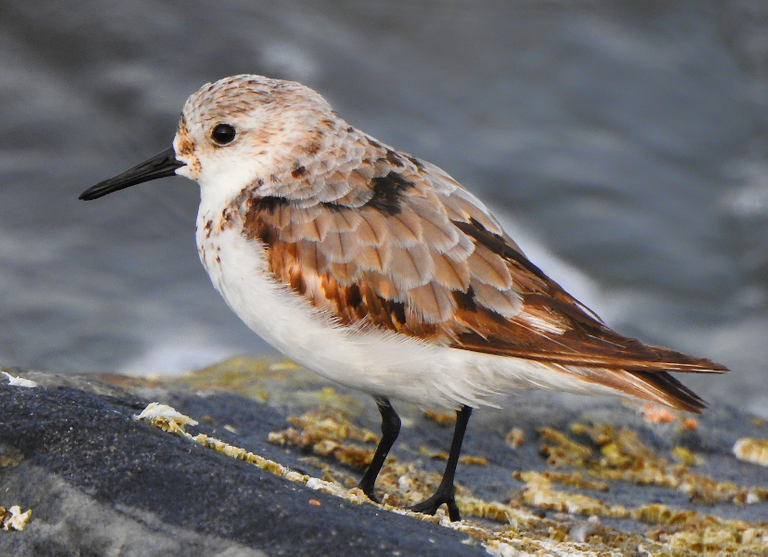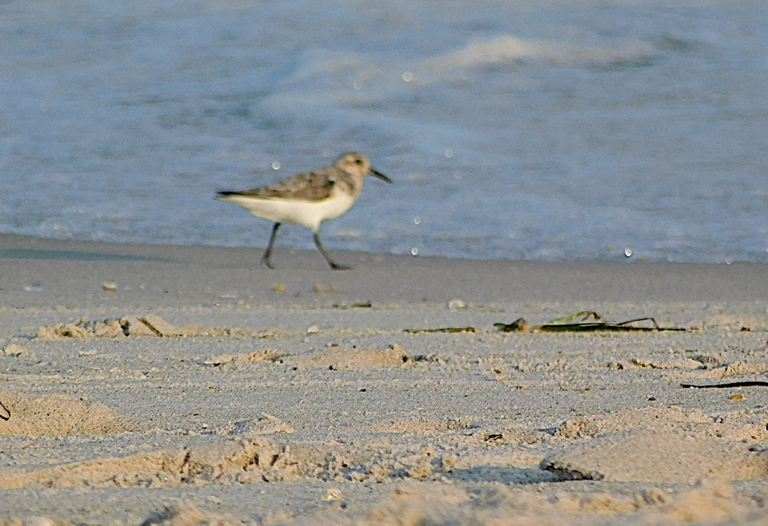Sanderlings, Non-Breeding Adults

agmoore
This summer I made a delightful discovery on a New York (USA) beach: the Sanderling (Calidris alba). The first thing I noticed about the small shorebird was its "obsessive wave chasing" (description offered by Cornell University site, All About Birds). The next thing I noticed about the frisky bird was that it congregated in large groups.
When I researched the behavior of Sanderlings, my informal observations about their habits were confirmed. Animal.net explains: "Sanderlings are social birds, and usually congregate in flocks....all the birds keep an eye out for predators. If one spots a predator, it alerts the rest of the flock and all the birds quickly take off into the air."
The chief predator of Sanderlings, outside of their nesting grounds, is the falcon.
Wave-chasing Sanderlings

agmoore
It was obvious the birds' frenetic scurrying about was in pursuit of food. They would run as a wave crashed and then stick their long beaks deep into the sand as the wave pulled out.
Sanderlings Hunting for Food in the Wake of a Retreating Wave

agmoore
I examined the sand to look for the food they were extracting. I did find minute sand crabs, and small gelatinous creatures that looked like baby jelly fish.
Tiny Holes Where Crabs Burrowed in the Sand, and Salps It was hard to catch the birds with something in their beaks, but I did capture a picture of one that was in the process of collecting food. The food appeared to be one of the baby jellyfish creatures. Sandpiper With Salp in its Grasp Up-close viewing of the tiny creatures revealed that they were, indeed, living organisms. With a some online research I discovered their name: salps. These chordate animals (means they have a dorsal nerve chord) are taxonomically closer to humans than than they are to jellyfish. Salps are so interesting that I will probably dedicate a future blog to them. I also researched the Sanderling diet, and discovered that Sanderlings are adaptive when it comes to food. They are omnivores. They eat plants and animals, vertebrates and invertebrates. They even eat biofilm, which is a living organism sort of in a category on its own. Often referred to as slime, or sea scum, this organic material is a major part of the shorebird's diet. Here is a Youtube video of a Sanderling foraging for sand crabs on a California beach (Video by Alicia's Moments in Nauture.)

agmoore

agmoore
Because foraging Sanderlings sometimes share a beach with humans, their behavior adapts somewhat to the potential danger of a human presence. Predictably, Sanderlings that often forage near humans may show a greater tolerance of this proximity, but in all cases a human approach can disrupt feeding. It was my personal observation at the beach, that the Sanderling is not as approachable as a gull, but is also not especially skittish.
This Sanderling didn't seem overly alarmed as I took its picture.

agmoore
While the Sanderling is one of the most common birds in the world, there have been reports of significant population declines in the Americas. These declines are believed to be attributed to climate change, which has disturbed their nesting areas in the Arctic, and also to destruction of shore habitat through pollution and development.
Classification
Phylum: Chordata
Class: Aves
Order: Charadriiformes
Family: Scolopacidae
Genus: Calidris

agmoore
The Sanderling is a sandpiper, in the family Scolopacidae. This is a family of shorebirds that generally breeds in the north and migrates long distances. The family includes sandpipers, curlews, phalaropes, and godwits (from Birdweb). In North America alone there are at least 22 species of sandpiper.
The Sanderling is the only sandpiper without a hind toe. According to several sources, this allows the small shorebird to run quickly.
Sanderling Walking: Absence of Hind Toe

agmoore
Reproduction and Migration
The tiny Sanderling has a migration pattern that rivals the Monarch butterfly's epic journey from Canada to Mexico. The Sanderling begins its life in the Arctic. The bird is a "circumpolar breeder in high arctic regions in Alaska, arctic Canada, north and east Greenland, Svalbard and western and central Siberia." (From the Norwegian Polar Institute.)
When breeding, Sanderlings change their plummage. Below is a picture of an adult breeding Sanderling.

Credit: Afsarnayakkan. Used under CC 4.0 International license.
The bird has been described as monogamous, polyandrous, polygynous and polygynandrous. There may be variations in the mating habits, depending (it is surmised) on the region in which the birds nest. Nests are on the ground, with perhaps some leaves spread around. Four eggs are laid, sometimes two clutches (separate group of four eggs). If a second clutch is laid, the male pitches in and helps to incubate one of them. Incubation may take approximately a month. By the time the young are about three weeks old, they are on their own.
Two Sanderlings, Waiting for the Next Wave

agmoore
The bird's migration takes it almost across the globe as it travels south in winter to shores in North America, South America, Europe, South Africa and Australia.
If you want to hear what Sanderlings sound like in flight, listen to this recording from the website British Bird Songs, UK. According to Animal Diversity.org, outside of the breeding season, Sanderlings are relatively quiet.
A Sanderling Walking on the Beach

agmoore
Lifespan
Sanderlings have been known to live 13 years. A recent study published in the Journal of Animal Ecology suggests that survival rates for the bird may be influenced by migratory distance. Birds that migrate to equatorial regions have poorer outcomes than those that migrate to areas south and north of the equator.
Anther factor that influences the survival of the birds and the success of their broods is the date of snow melt in the breeding grounds. A late melt can have a devastating effect on bird and brood survival. There may not be enough food to sustain the birds or their young, and the young may perish in the cold.
As is true of other wildlife, loss of habitat and pollution are also threats to the Sanderling. In North Carolina (USA) the bird is a 'species of concern'.
Three Sanderlings on the Beach

agmoore
These birds have few defenses against predators. Their colors help to camouflage them. They also call out to each other and their young when danger is perceived. The response of a flock may be to take to the skies. The response of threatened young Sanderlings is likely to be that the threatened bird freezes in place and hopes to escape notice.
A Sanderling Extracting Some Sort of Food From the Surf

agmoore
Conclusion
I hope you have enjoyed reading about this little shorebird. When I first saw Sanderlings I thought they were terns. I didn't know much about terns or Sanderlings. The more I read about Sanderlings, the more interesting they become. Though this may be the last time I write about this bird on Hive (who knows?), it certainly will not be the last time I study them.

Resources
Illustration at the end of the blog: Shells: @muelli from LIL, the LMAC Image Library. The bird was extracted from one of my photos.
***All photos not otherwise credited were taken by me.
1.https://www.allaboutbirds.org/guide/Sanderling/overview
2.https://animals.net/sanderling/
3.https://interpretivecenter.org/salps-a-mystery-on-the-beach/
4.https://australian.museum/learn/animals/sea-squirts/what-is-a-salp/
5.https://www.researchgate.net/publication/325093726_The_food_web_perspective_on_aquatic_biofilms
6.https://digitalcommons.coastal.edu/cgi/viewcontent.cgi?article=1334&context=honors-theses
7.https://abcbirds.org/bird/sanderling/
8.https://climateactiontool.org/species/sanderling
9.https://www.chesapeakebay.net/discover/field-guide/entry/sanderling
10.https://goodheartextremescience.wordpress.com/2010/01/27/meet-the-amazing-salp/
11.https://academic.oup.com/bioscience/article/49/9/689/246823
12.https://www.eopugetsound.org/magazine/biofilm
13.https://www.youtube.com/channel/UCf6BfLjfjRXlrUA4Fr_tSow
14.https://birdweb.org/birdweb/family/scolopacidae
15.https://www.birds-of-north-america.net/sandpipers.html
16.https://imbirdingrightnow.com/2019/05/28/answers-bird-quiz-3-loafing-shorebirds/
17.https://monarchjointventure.org/monarch-biology/monarch-migration
18.https://www.npolar.no/en/species/sanderling/
19.https://animaldiversity.org/accounts/Calidris_alba/
20.https://www.british-birdsongs.uk/sanderling/
21.https://besjournals.onlinelibrary.wiley.com/doi/full/10.1111/1365-2656.13187
22.https://www.arctictoday.com/unusual-late-spring-snow-devastated-shorebirds-northeast-greenland/
23.https://sites.google.com/site/savetheshorebirdsnc/species-list/sanderling
24.http://www.biokids.umich.edu/critters/Calidris_alba/